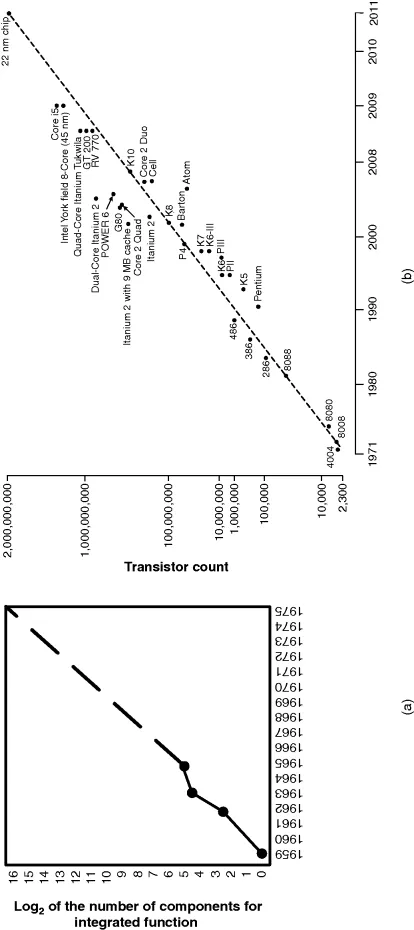![]()
Chapter 1
Overview
No exponential is forever … but we can delay “forever”
Gordon Moore
1.1 Introduction
This chapter begins from the assertion that the advent of VLSI (very large scale integration) has enabled solutions to intractable engineering problems. Gordon Moore predicted in 1965 the rate of development of VLSI technology, and the industry has indeed been developing newer technologies riding on his predicted curve. This rapid advancement has led to new dimensions in the core subject of VLSI. The capability to place billions of transistors in a small silicon area has tested the creativity of engineers and scientists around the world. The subject of digital design for signal processing systems embraces these new challenges. VLSI has revolutionized the commercial market, with products regularly appearing with increasing computational power, improved battery life and reduced physical size.
This chapter discusses several applications. The focus of the book is on applications primarily in areas of signal processing, multimedia, digital communication, computer networks and data security. Some of the applications are shown in Figure 1.1.
Multimedia applications have had a dramatic impact on our lives. Multimedia access on handheld devices such as mobile phones and digital cameras is a direct consequence of this technology.
Another area of application is high-data-rate communication systems. These systems have enormous real-time computational requirements. A modern mobile phone, for example, executes several complex algorithms, including speech compression and decompression, forward error-correction encoding and decoding, highly complex modulation and demodulation schemes, up-conversion and down-conversion of modulated and received signals, and so on. If these are implemented in software, the amount of real-time computation may require the power of a supercomputer. Advancement in VLSI technology has made it possible to conveniently accomplish the required computations in a hand-held device. We are also witnessing the dawn of new trends like wearable computing, owing much to this technology.
Broadband wireless access technology, processing many megabits of information per second, is another impressive display of the technology, enabling mobility to almost all the services currently running on desktop computers. The technology is also at work in spacecraft and satellites in space imaging applications.
The technology is finding uses in biomedical equipment, examples being digital production of radiographic and ultrasound images, and implantable devices such as the cardioverter defibrillator that acquires and digitizes heartbeats, detects any rhythmic abnormalities and symptoms of sudden cardiac arrest and applies an electric shock to help a failing heart.
This chapter selects a mobile communication system as an example to explain the design partitioning issues. It highlights that digital design is effective for mapping structured algorithms in silicon. The chapter also considers the design of a backplane of a high-end router to reveal the versatility of the techniques covered in this book to solve problems in related areas where performance is of prime importance.
The design process has to explore competing design objectives: speed, area, power, timing and so on. There are several mathematical transformations to help with this. Keeping in perspective the defined requirement specifications, transformations are applied that trade off less relevant design objectives against the other more important objectives. That said, for complex design problems these mathematical transformations are of less help, so an effective approach requires learning several ‘tricks of the trade’. This book aims to introduce the transformations as well as giving tips for effective design.
The chapter highlights the impact of the initial ideas on the entire design process. It explains that the effect of design decisions diminishes as the design proceeds from concept to implementation. It establishes the rational for the system architect to positively impact the design process in the right direction by selecting the best option in the multidimensional design space. The chapter explores the spectrum of design options and technologies available to the designer. The design options range from the most flexible general-purpose computing machine like Pentium, to commercially available off-the-shelf digital signal processors (DSPs), to more application-specific instruction-set processors, to hard-wired application-specific designs yielding best performance without any consideration of flexibility in the solution. The chapter describes the target technologies on which the solution can be mapped, like general-purpose processors (GPPs), DSPs, application-specific integrated circuits (ASICs), and field-programmable gate arrays (FPGAs). It is established that, for complex applications, an optimal solution usually consists of a mix of these target technologies.
This chapter presents some design examples. The rationale for design decisions for a satellite burst modem receiver is described. There is a brief overview of the design of the backplane of a router. There is an explanation of the design of a network-on-chip (NoC) carrier-class VoIP media gateway. These examples follow a description of the trend from digital-only design to mixed-signal system-on-chips (SoCs). The chapter considers synchronous digital circuits where digital clocks are employed to make all components operate synchronously in implementing the design.
1.2 Fueling the Innovation: Moore's Law
Advancements in VLSI over a few decades have played a critical role in realizing the amazing electronic gadgets we live with today. Gordon Moore, founder of Intel, earlier predicted the rapid rate of these advancements. In 1965 he noted that the number of transistors on a chip was doubling every 18 to 24 months. Figure 1.2a shows the predicted curve known as Moore's Law from his original paper [1]. This ‘law’ has fueled innovation for five decades. Figure 1.2b shows Intel's response to his prediction.
Moore acknowledges that the trend cannot last forever, and he gave a presentation at an international conference, entitled “No exponential is forever, but we can delay ‘forever’” [2]. Intel has plans to continue riding on the Moore's Law curve for another ten years and has announced a 2.9 billion-transistor chip for the second quarter of 2011. The chip will fit into an area the size of a fingernail and use 22-nanometer technology [3]. For comparison, the Intel 4004 microprocessor introduced in 1971 was based on a 10 000-nanometer process.
Integration at this scale promises enormous scope for designers and developers, and the development of design tools has matched the pace. These tools provide a level of abstraction so that the designer can focus more on higher level design concepts rather than low-level details.
1.3 Digital Systems
1.3.1 Principles
To examine the scope of the subject of digital design, let us consider an embedded signal processing system of medium complexity. Usually such a system consists of heterogeneous physical devices such as a GPP or micro-controller, multiple DSPs, a few ASICs, and FPGAs. An application implemented on such a system usually consists of numerous tasks of varying computational complexity. These tasks are mapped on to the physical devices. The decision to implement a particular task on a particular device is based on the computational complexity of the task, its code density, and the communication it requires with other tasks.
The computationally intensive (‘number-crunching’) tasks of the application can be further divided into categories. The tasks for which commercial off-the-shelf ASICs are available are best mapped on these devices. ASICs are designed to perform specific functions of a particular application and are not programmable, as are GPPs. Based on the target technology, ASICs are of different types, examples of which are full-custom, standard-cell-based, gate-array-based, channeled gate array, channel-less gate array, and structured gate array. As these devices are application-specific they are optimized using integrated-circuit manufacturing process technology. These devices offer low cost and low power consumption. There are many benefits to using ASICs, but because of their fixed implementation a design cannot be made easily upgradable.
It is important to point out that several applications implement computationally intensive but non-standard algorithms. The designer, for these applications, may find that mapping the entire application on FPGAs is the only option for effective implementation. For applications that consist of standard as well as non-standard algorithms, the computationally intensive tasks are further divided into two groups: structured and non-structured. The tasks in the structured group usually consist of code that has loops or nested loops with a few instructions being repeated a number of times, whereas the tasks in the non-structured group implement more code-intensive components. The structured tasks are effectively mapped on FPGAs, while the non-structured parts of the algorithm are implemented on a DSP or multiple DSPs.
A field-programmable gate array comprises a matrix of configurable logic blocks (CLBs) embedded in an interconnected net. The FPGA synthesis tools provide a method of programming the configurable logic and the interconnects. The FPGAs are bought off the shelf: Xilinx [4], Altera [5], Atmel [6], Lattice Semiconductor [7], Actel [8] and QuickLogic [9] are some of the prominent vendors. Xilinx shares more than 50% of the programmable logic device (PLD) segment of the semiconductor industry.
FPGAs offer design reuse, and better performance than a software solution mapped on a DSP or GPP. They are, however, more expensive and give reduced performance and more power consumption compared with an equivalent ASIC solution if it exists. The DSP, on the other hand, is a microprocessor whose architecture is specially designed to support number-crunching signal processing applications. Usually a DSP can perform many multiplication and addition operations and supports special addressing modes that help in effective implementation of fast Fourier transform (FFT) and convolution algorithms.
The GPPs or microcontrollers are general-purpose computing machines. Types are ‘complex instruction set computer’ (CISC) and ‘reduced instruction set computer’ (RISC).
The tasks specific to user interfaces, control processes and other code-intensive protocols are usually mapped on GPPs or microcontrollers. For handling multiple concurrent tasks, events and interrupts, the microcontroller runs a real-time operating system. The GPP is also good at performing general tasks like configuring various devices in the system and interf...


